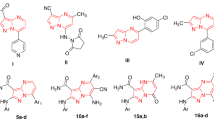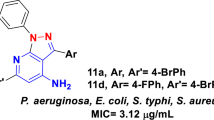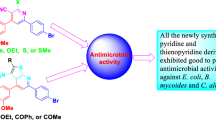Abstract
In this work it is described the synthesis, characterization and antimicrobial and toxicity evaluation of a series of analogs of piplartine, a piperamide found in Piper sp. The compounds structures were confirmed by infrared spectroscopy, 1H, 13C nuclear magnetic resonance, high resolution mass spectroscopy and were evaluated against strains of Candida spp., Staphylococcus aureus, Escherichia coli and Pseudomonas aeruginosa. Derivative 24 was almost four-fold more potent (IC50: 48.83 μM) and five-fold less toxic (SI > 3) than piplartine (IC50: 189.2 μM; SI: 0.21) against Candida krusei, as well as two-fold more potent than fluconazole (IC50: 104.48 μM). This compound was also active against Candida tropicalis at 97.67 μM. Benzoyl derivative 17 was three-fold more potent (IC50: 85.2 μM) and more than five-fold less toxic (CC50: 231.71 μM) than piplartine (IC50: 315.33 μM and CC50: 41.14 μM) against Staphylococcus aureus. Given these findings, we have found analogs of piplartine which can be assumed as prototypes for the optimization and the development of new antimicrobial (compounds 24 and 17) agents.



Similar content being viewed by others
References
Abrão PHO, Pizi RB, Souza TB, Silva NC, Fregnan AM, Silva FN, Coelho LFL, Malaquias LCC, Dias ALT, Dias DF, Veloso MP, Carvalho DT (2015) Synthesis and biological evaluation of new eugenol Mannich bases as promising antifungal agents. Chem Biol Drug Des 86:459–465
Adams DJ, Dai M, Pellegrino G, Wagner BK, Stern AM, Shamji AF, Schreiber SL (2012) Synthesis, cellular evaluation, and mechanism of action of piperlongumine analogs. PNAS 109:15115–15120
Alécio AC, Bolzani VS, Young MCM, Kato MJ, Furlan M (1998) Antifungal amide from leaves of Piper hispidum. J Nat Prod 61:637–639
Balunas MJ, Kinglorn AD (2005) Drug discovery from medicinal plants. Life Sci 78:431–441
Bezerra DP, Castro FO, APNN Alves, Pessoa C, Moraes MO, Silveira ER, Lima MAS, Elmino FJM, Costa-Lotufo LV (2006) In vivo growth-inhibition of Sarcoma 180 by piplartinee and piperine, two alkaloid amides from Piper. Braz J Med Biol Res 39:801–807
Bezerra DP, Pessoa C, Moraes MO, Saker-Neto N, Silveira ER, Costa-Lotufo LV (2013) Overview of the therapeutic potential of Piplartine (piperlongumine). Eur J Pharm Sci 48:453–463
Carvalho SA, Feitosa LO, Soares M, Costa TEMM, Henriques MG, Salomão K, Castro SL, Kaiser M, Brum R, Wardell JL, Wardell SMSV, Trossini GHG, Andricopulo AD, Barreiro EB, Mansour CAM (2012) Design and synthesis of new (E)-cinnamic N-acylhydrazones as potent antitrypanosomal agents. Eur J Med Chem 54:512–521
Chen J, Li W, Yao H, Xu J (2015) Insights into drug discovery from natural products through structural modification. Fitoterapia 103:231–241
Chin Y, Balunas MJ, Chai H, Kinghorn AD (2006) Drug discovery from natural sources. AAPS J 8:239–253
Cotinguiba F, Regasini LO, Bolzani VS, Debonsi HM, Passerini GD, Cicarelli RMD, Kato MJ, Furlan M (2009) Piperamides and their derivatives as potential anti-trypanosomal agents. Med Chem Res 18:703–711
Cragg MG, Newman J (2005) Plants as a source of anti-cancer agents. J. Ethnopharmacol 100:72–79
Clinical And Laboratory Standards Institute CLSI (2008) Reference method for broth dilution antifungal susceptibility testing of yeasts; Approved standard M27-A3, 3th edn. National Committee for Clinical Laboratory Standards, Wayne, PA
Clinical And Laboratory Standards Institute CLSI (2012) Methods for dilution antimicrobial susceptibility testes for bacteria that grow aerobically; Approved standard M07-A9, 9th edn. National Committee for Clinical Laboratory Standards, Wayne, PA
Joshi SD, More U, Dixit SR, Korat HH, Aminabhavi TM, Badiger AM (2014) Synthesis, characterization, biological activity, and 3D-QSAR studies on some novel class of pyrrole derivatives as antitubercular agents. Med Chem Res 23:1123–1147
Kumar JU, Shankaraiah G, Kumar RSC, Pitke VV, Rao GT, Poornima B, Babu KS, Sreedhar AS (2013) Synthesis, anticancer, and antibacterial activities of piplartine derivatives on cell cycle regulation and growth inhibition. J Asian Nat Prod Res 15:658–669
Lampe JW (2003) Spicing up a vegetarian diet: chemopreventive effects of phytochemicals. Am J Clin Nutr 78:579–583
Lee SE, Park BS, Bayman P, Baker JL, Choi WS, Campbell BC (2007) Campbell, suppression of ochratoxin biosynthesis by naturally occurring alkaloids. Food Add Contam 24:391–397
Lee S, Park B, Kim M, Choi W, Kim H, Cho K, Lee S, Lee H (2001) Fungicidal activity of pipernonaline, a piperidine alkaloid derived from long pepper, Piper longum L., against phytopathogenic fungi. Crop Prot 20:523–528
Ling LL, Scheider T, Peoples AJ, Spoering AL, Engels I, Conlon BP, Mueller A, Schäberle TF, Hughes DE, Epstein S, Jones M, Lazarides L, Steadman VA, Cohen DR, Feliz CR, Fetterman KA, Mellert WP, Nitti AG, Zullo AM, Chen C, Lewis K (2015) A new antibiotic kills pathogens without detectable resistance. Nature 517:455–459
Low CY, Rotstein C (2011) Emerging fungal infections in immunocompromised patients. F100 Med Rep 3:1–8
Moraes J, Nascimento C, Yamaguchi LF, Kato MJ, Nakano E (2012) Schistosoma mansoni: In vitro schistosomicidal activity and tegumental alterations induced by piplartine on schistosomula. Exp Parasitol 132:222–227
Naika R, Prasannal KP, Ganapathy PSS (2010) Antibacterial activity of piperlongumine an alkaloid isolated from methanolic root extract of Piper longum L. Pharmacophore 1:141–148
Navickiene HMD, Alécio AC, Kato MJ, Bolzani VS, Young MCM, Cavalheiro AJ, Furlan M (2006) Antifungal amides from Piper hispidum and Piper tuberculatum. Phytochemistry 55:621–626
Okwute SK, Egharevba HO (2013) Egharevba, Piperine-type amides: review of the chemical and biological characteristics. Int J Chem 5:99–122
Park B, Son D, Choi W, Takeoka GR, Han SO, Kim T, Lee S (2008) Antiplatelet activities of newly synthesized derivatives of piperlongumine. Phytother Res 22:1195–1199
Paterson I, Anderson EA (2005) The renaissance of natural products as drug candidates. Science 310:451–453
Prashanth MK, Revanasiddappa HD, Rai KML, Veeresh B (2012) Synthesis, characterization, antidepressant and antioxidant activity of novel piperamides bearing piperidine and piperazine analogues. Bioorg Med Chem Lett 22:7065–7070
Prithwiraj GKY, Constant P, Bedos-Belval F, Duran H, Saffon N, Daffe M, Baltas M (2011) Design, synthesis, and biological evaluation of new cinnamic derivatives as antituberculosis agents. J Med Chem 54:1449–1461
Rao VR, Muthenna P, Shankaraiah G, Akileshwari C, Babu KH, Suresh G, Babu KS, Kumar RSC, Prasad KR, Yadav PA, Petrash JM, Reddy GB, Rao JM (2012) Synthesis and biological evaluation of new piplartine analogues as potent aldose reductase inhibitors (ARIs). Eur J Med Chem 57:344–361
Reddy PS, Jamil K, Madhusudhan P, Anjani G, Das B (2011) Antibacterial activity of isolates from Piper longum and Taxus baccata. Pharm Biol 39:36–238
Silva RV, Navickiene HMD, Kato MJ, Bolzani VS, Méda CI, Young MCM, Furlan M (2012) Antifungal amides from Piper arboreum and Piper tuberculatum. Phytochemistry 59:521–527
Souza TB, Orlandi M, Coelho LFL, Malaquias LCC, Dias ALT, Carvalho RR, Silva NC, Carvalho DT (2014) Synthesis and in vitro evaluation of antifungal and cytotoxic activities of eugenol glycosides. Med Chem Res 23:496–502
Souza TB, Raimundo POB, Andrade SA, Hipólito TMM, Silva NCS, Dias ALT, Ikegaki M, Rocha RP, Coelho LFL, Veloso MP, Carvalho DT, Dias DF (2015) Synthesis and antimicrobial activity of 6-triazolo-6-deoxy eugenol glucosides. Carbohydr Res 410:1–8
Sun L, Wang F, Dai F, Wang Y, Lin D, Zhou B (2015) Development and mechanism investigation of a new piperlongumine derivative as a potent anti-inflammatory agent. Biochem Pharmacol 95:156–169
Acknowledgments
This work was supported by FAPEMIG (APQ-01209-13), CAPES, CNPq and FINEP.
Author information
Authors and Affiliations
Corresponding author
Ethics declarations
Conflict of Interest
The authors declare that they have no competing interests.
Electronic supplementary material
Rights and permissions
About this article
Cite this article
Fregnan, A.M., Brancaglion, G.A., Galvão, A.F.C. et al. Synthesis of piplartine analogs and preliminary findings on structure–antimicrobial activity relationship. Med Chem Res 26, 603–614 (2017). https://doi.org/10.1007/s00044-016-1774-9
Received:
Accepted:
Published:
Issue Date:
DOI: https://doi.org/10.1007/s00044-016-1774-9




